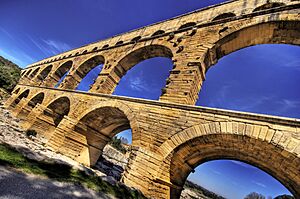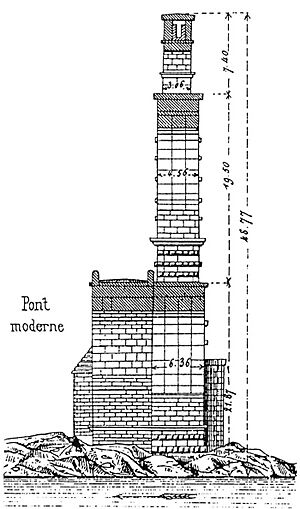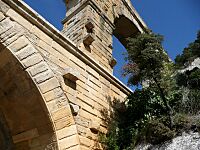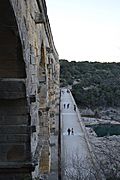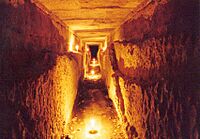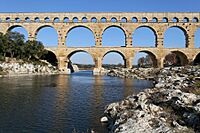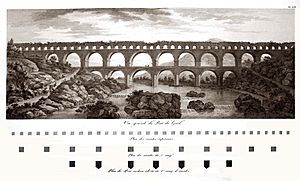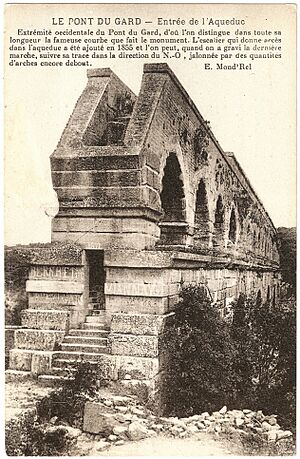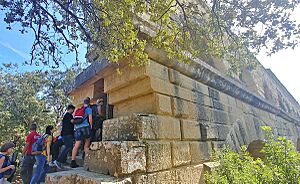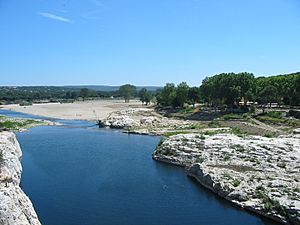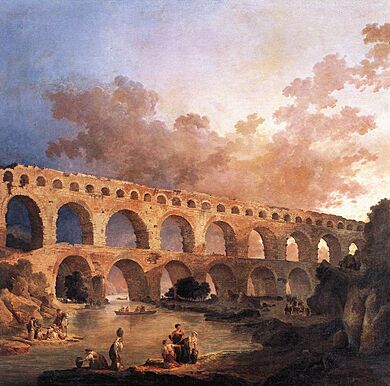Pont du Gard facts for kids
Quick facts for kids Pont du Gard |
|
|---|---|
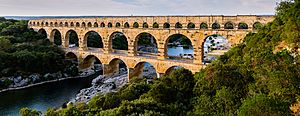 |
|
| Coordinates | 43°56′50″N 04°32′08″E / 43.94722°N 4.53556°E |
| Carries | Roman aqueduct of Nîmes |
| Crosses | Gardon River |
| Locale | Vers-Pont-du-Gard, Gard, France |
| Maintained by | Public Association of Cultural Cooperation (since 2003) |
| Characteristics | |
| Design | Arch bridge |
| Material | Shelly limestone |
| Total length |
|
| Width |
|
| Height |
|
| Number of spans |
|
| Piers in water | 5 |
| History | |
| Construction end | c. 40–60 AD |
| Construction cost | 30 million sesterces (est.) |
| Closed | c. 6th century |
| Official name: Pont du Gard (Roman Aqueduct) | |
| Type: | Cultural |
| Criteria: | i, iii, iv |
| Designated: | 1985 (9th session) |
| Reference #: | 344 |
| Region: | Europe and North America |
|
Monument historique
|
|
| Designated: | 1840 |
| Reference #: | PA00103291 |
The Pont du Gard is an amazing ancient Roman aqueduct bridge. It was built almost 2,000 years ago, around 40-60 AD. Its job was to carry fresh water over 50 kilometers (about 31 miles) to the Roman city of Nemausus, which is now Nîmes.
This incredible bridge crosses the Gardon River in southern France, near a town called Vers-Pont-du-Gard. The Pont du Gard is one of the best-preserved Roman aqueduct bridges in the world. Because it is so well-preserved and important, UNESCO added it to its list of World Heritage sites in 1985.
Contents
What is the Pont du Gard?
The Pont du Gard is a huge bridge made of Shelly limestone. It has three levels of arches stacked on top of each other. The bridge stands about 48.8 meters (160 feet) tall. Imagine a 16-story building!
This aqueduct used to carry a massive amount of water every day. About 40,000 cubic meters (10.5 million US gallons) of water flowed through it. This water supplied the fountains, baths, and homes in Nîmes. The Romans were very clever engineers. They built the aqueduct with a tiny slope, only 1 centimeter (0.4 inches) for every 182.4 meters (598 feet). This allowed the water to flow steadily.
The aqueduct was likely used until the 6th century AD. Over time, it became clogged with minerals and debris. This happened because people stopped maintaining it after the 4th century. Eventually, the water stopped flowing.
After the Roman Empire ended, the Pont du Gard was still useful. It became a toll bridge for people to cross the river. Local lords and bishops took care of it for centuries. They charged a fee to travelers who used the bridge. Some of its stones were taken over time, and it was damaged in the 17th century. However, it became a popular tourist spot in the 18th century.
Many repairs happened between the 18th and 21st centuries. In 2000, a new visitor center opened. Cars and buildings were removed from around the bridge. Today, it is one of France's most popular tourist attractions. Many famous writers and artists have visited it.
How the Nîmes Aqueduct Worked

Finding water for the city of Nemausus (Nîmes) was a challenge. The city was surrounded by plains and hills that made it hard to get water. The best option was to bring water from natural springs near a town called Ucetia (Uzès).
The Nîmes aqueduct was built to bring water from the Fontaine d'Eure springs to a special water distribution center in Nîmes. From there, the water went to fountains, baths, and homes. The springs and Nîmes are only about 20 kilometers (12 miles) apart in a straight line. But the aqueduct took a winding path of about 50 kilometers (31 miles).
This long, winding route was necessary to go around the hills called the Garrigues de Nîmes. These hills were difficult to cross. They had thick plants and deep valleys. The Romans could not tunnel through 8 to 10 kilometers (5 to 6 miles) of rock. So, building a V-shaped path around the hills was the only way.
The Fontaine d'Eure springs are 76 meters (249 feet) above sea level. The water distribution center in Nîmes is 17 meters (56 feet) lower. This difference in height was enough to keep the water flowing to the 50,000 people in the Roman city. The aqueduct's average slope was very gentle, only 1 unit down for every 3,000 units forward.
The Pont du Gard itself drops only 2.5 centimeters (1 inch) over 456 meters (1,496 feet). This is a slope of 1 in 18,241. The Roman engineers had to change the slope along the aqueduct's path. If the slope was always the same, the Pont du Gard would have been too tall to build with their technology. By changing the slope, they made the bridge 6 meters (20 feet) shorter, bringing it to 48.77 meters (160 feet) above the river. This was still very high for Roman bridges!
It is thought that the aqueduct delivered about 40,000 cubic meters (10.5 million US gallons) of water daily. It took almost 27 hours for the water to travel from the springs to the city. The water arrived at a large, round basin in Nîmes. This basin was 5.5 meters (18 feet) wide and 1 meter (3 feet) deep. From this basin, ten large holes directed water into the city's main pipes.
The spring water was pure but contained a lot of calcium carbonate from the surrounding limestone. This caused problems for the Romans. The calcium carbonate would build up inside the aqueduct channel. This reduced the water flow. Plant roots also grew into the channel, blocking the water. Workers called circitores had to constantly clean the aqueduct. They would crawl inside to scrub the walls and remove plants.
Most of the Nîmes aqueduct was built underground. This was common for Roman aqueducts. Workers dug a trench, built a stone channel, and covered it with stone slabs and earth. Some parts were even tunneled through solid rock. About 35 kilometers (22 miles) of the aqueduct was underground. Other parts were carried on walls or bridges. The Pont du Gard is the best-preserved section of the entire aqueduct.
How the Bridge Looks and Was Built
The Pont du Gard is 49 meters (161 feet) high above the river and 274 meters (899 feet) long. Its width changes from 9 meters (30 feet) at the bottom to 3 meters (10 feet) at the top. The three levels of arches are set back from each other. The main support pillars line up directly above each other. The arches are not all the same size. Each was built slightly differently to help the bridge withstand ground movement.
Here's a quick look at its levels:
| Level | Number of arches | Length of level | Thickness of pillars | Height of arches |
|---|---|---|---|---|
| Bottom (1st row) | 6 | 142 meters (466 feet) | 6 meters (20 feet) | 22 meters (72 feet) |
| Middle (2nd row) | 11 | 242 meters (794 feet) | 4 meters (13 feet) | 20 meters (66 feet) |
| Top (3rd row) | 35 (originally 47) | 275 meters (902 feet) | 3 meters (10 feet) | 7 meters (23 feet) |
The lowest level of the Pont du Gard has a road bridge next to it. This road bridge was added in the 18th century. The water channel, called the specus, is at the very top of the third level. It is about 1.8 meters (6 feet) high and 1.2 meters (4 feet) wide.
The upper levels of the bridge curve slightly upstream. People once thought this was a clever design to make the bridge stronger against the river's flow. But studies in 1989 showed that the stone expands and shrinks with the sun's heat. This movement, over hundreds of years, caused the curve.
The Pont du Gard was built mostly without mortar or clamps. It contains about 50,400 tons of limestone. Some individual blocks weigh up to 6 tons! Most of the stone came from a local quarry about 700 meters (2,300 feet) downstream. The blocks were cut so precisely that they fit together perfectly. This meant no mortar was needed. The builders even left messages and instructions on the stones. Many blocks were numbered to guide the workers.
Historians understand a lot about how it was built. A rich person or the city of Nîmes hired many workers. A surveyor used special tools to plan the route and measure the levels. Builders used cranes and pulleys to lift the heavy stones. For the biggest blocks, a huge human-powered treadmill crane was used. A complex scaffolding system supported the bridge during construction. The whole project was very expensive, costing millions of Roman coins.
- Features of the Pont du Gard
-
The water tank or castellum divisorum at Nîmes, into which the aqueduct emptied. The round holes were where the city's water supply pipes connected to the tank.
Even though the outside of the Pont du Gard looks rough, the inside of the water channel was very smooth. This was important so the water could flow easily. The channel walls were made of carefully cut stone. The floor was concrete. Both were covered with a special plaster that included tiny pieces of pottery and tile. This surface was then treated to make it smooth and strong.
The design of the Pont du Gard, with arches stacked high, was impressive but not the most efficient. Later Roman aqueducts used more concrete. This made them lighter and cheaper to build. For example, the Aqueduct of Segovia in Spain used fewer arches for a similar length.
History of the Pont du Gard
For a long time, people thought the Roman emperor Augustus's son-in-law, Marcus Vipsanius Agrippa, built the aqueduct around 19 BC. He was in charge of Rome's water supply. However, newer discoveries suggest it was built later, between 40 and 60 AD. Coins found in Nîmes are from the time of Emperor Claudius (41–54 AD). Experts now believe the aqueduct was finished around the middle of the 1st century AD. It probably took about fifteen years to build, with 800 to 1,000 workers.
After the 4th century, the aqueduct was not maintained well. Invaders caused problems in the region. The channel became blocked with dirt, mineral crusts, and plant roots. This greatly slowed down the water flow. The deposits on the walls were up to 50 centimeters (20 inches) thick. While some thought it was used until the 9th century, newer studies suggest it stopped working around the 6th century.
Even though some stones were taken, the Pont du Gard stayed mostly whole. This was because it was used as a toll bridge. In the 13th century, the French king gave local lords the right to charge tolls for crossing the bridge. Later, the Bishops of Uzès had this right. In return, they had to keep the bridge in good condition.
However, the bridge was badly damaged in the 1620s. Henri, Duke of Rohan, used the bridge to move his cannons during wars. To make space for his artillery, he had part of the second row of arches cut away. This made a wide gap for carts but seriously weakened the bridge.
In 1703, local leaders repaired the Pont du Gard. They fixed cracks and replaced missing stones. A new road bridge was built next to the lower arches in 1743–47 by engineer Henri Pitot. This allowed road traffic to cross on a separate bridge. The famous writer Alexandre Dumas was not happy about the new bridge. He said it "dishonored a monument which the barbarians of the fifth had not dared to destroy." The Pont du Gard continued to get worse. By 1835, it was in danger of collapsing.
Napoleon III, who admired Roman history, visited the Pont du Gard in 1850. He approved plans to repair the bridge. Architect Charles Laisné led the project from 1855 to 1858. The work included replacing worn stones and making the bridge more stable. Stairs were added so visitors could safely walk along the water channel.
Since then, there have been more projects to strengthen the bridge. It has survived three major floods in the last century. In 1958, the entire lower level was underwater. In 1998 and 2002, more floods caused damage to nearby areas.
The Pont du Gard was recognized by UNESCO in 1985. They called it a "technical as well as artistic masterpiece."
Visiting the Pont du Gard
The Pont du Gard has been a popular place to visit for hundreds of years. The amazing stonework made it a must-see for French traveling masons. Many of them carved their names into the stones. From the 18th century, it became a famous stop for travelers on the "Grand Tour." It became known as an important historical site and a symbol of French pride.
French kings also visited the bridge. They wanted to connect themselves with the power of the Roman Empire. King Charles IX of France visited in 1564. Louis XIV and his court visited in 1660. In 1786, King Louis XVI asked artist Hubert Robert to paint the Pont du Gard. This painting was meant to show the link between the French monarchy and the Roman past. Napoleon III also supported the bridge's restoration in the 1850s.
By the 1990s, the Pont du Gard was a very popular tourist spot. But it was crowded with cars and illegal shops. In 1996, a big project began to improve the area. The area around the bridge became a pedestrian zone. A new visitor center was built. This made the area much quieter and gave visitors a better understanding of the bridge's history. Today, the Pont du Gard is one of France's top five tourist attractions. It had 1.4 million visitors in 2001.
Famous Writers and the Pont du Gard
Many famous writers have visited the Pont du Gard and shared their experiences. Jean-Jacques Rousseau was amazed when he saw it in 1738. He wrote that it was the first Roman work he had seen. He said it was "a monument worthy of the hands which had constructed it." He wondered how such huge stones were moved and how so many people worked in such a wild place. He felt tiny next to its immensity.
The novelist Henry James visited in 1884. He called the Pont du Gard "unspeakably imposing." He said its "hugeness, the solidity, the unexpectedness" left him speechless. He felt it was "noble and perfect." As twilight fell, he felt the "shadow of the Roman name." He believed no other people had been as great as the Romans.
Hilaire Belloc wrote in 1928 that the bridge's "isolation, its dignity, its weight, are all three awful." He said it looked like it was built by "beings greater than ourselves." He felt a person could find peace there.
More to Explore
- Eifel Aqueduct
- List of Roman aqueduct bridges
- List of bridges in France
See also
 In Spanish: Puente del Gard para niños
In Spanish: Puente del Gard para niños


